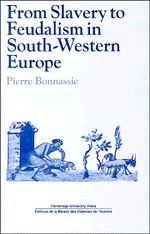Book contents
- Frontmatter
- Contents
- List of maps
- Foreword by T. N. Bisson
- Abbreviations
- 1 The survival and extinction of the slave system in the early medieval West (fourth to eleventh centuries)
- 2 Society and mentalities in Visigothic Spain
- 3 From the Rhône to Galicia: origins and modalities of the feudal order
- 4 Descriptions of fortresses in the Book of Miracles of Sainte-Foy of Conques
- 5 The formation of Catalan feudalism and its early expansion (to c. 1150)
- 6 Feudal conventions in eleventh-century Catalonia
- 7 The noble and the ignoble: a new nobility and a new servitude in Catalonia at the end of the eleventh century
- 8 Rural communities in Catalonia and Valencia (from the ninth to the mid-fourteenth centuries) (in collaboration with Pierre Guichard)
- 9 From one servitude to another: the peasantry of the Frankish kingdom at the time of Hugh Capet and Robert the Pious (987–1031)
- 10 Marc Bloch, historian of servitude: reflections on the concept of ‘servile class’
- Index
- Past and Present Publications
6 - Feudal conventions in eleventh-century Catalonia
Published online by Cambridge University Press: 04 August 2010
- Frontmatter
- Contents
- List of maps
- Foreword by T. N. Bisson
- Abbreviations
- 1 The survival and extinction of the slave system in the early medieval West (fourth to eleventh centuries)
- 2 Society and mentalities in Visigothic Spain
- 3 From the Rhône to Galicia: origins and modalities of the feudal order
- 4 Descriptions of fortresses in the Book of Miracles of Sainte-Foy of Conques
- 5 The formation of Catalan feudalism and its early expansion (to c. 1150)
- 6 Feudal conventions in eleventh-century Catalonia
- 7 The noble and the ignoble: a new nobility and a new servitude in Catalonia at the end of the eleventh century
- 8 Rural communities in Catalonia and Valencia (from the ninth to the mid-fourteenth centuries) (in collaboration with Pierre Guichard)
- 9 From one servitude to another: the peasantry of the Frankish kingdom at the time of Hugh Capet and Robert the Pious (987–1031)
- 10 Marc Bloch, historian of servitude: reflections on the concept of ‘servile class’
- Index
- Past and Present Publications
Summary
In 1959, in an important article which remains the only thing written on the subject, Paul Ourliac drew historians' attention to a type of act still little known, even though absolutely characteristic of the history of southern societies between the tenth and the twelfth centuries: the convenientiae. These agreements or ‘covenants’, common throughout Lombardy, Provence, Languedoc and Catalonia, and occasionally found as far afield as Aragon and the Loire valley, can be defined as contracts by which two parties agreed between them, freely and without the intervention of any public or private jurisdiction, the definition of the obligations binding one to the other, and guaranteed their execution by a solemn engagement. Highly original in their form, and without antecedents in Roman or barbarian law, these contracts were employed for a wide variety of purposes. In Catalonia, in particular, the range of the convenientiae is enormous; they can be seen variously applying to, for example, a promise of marriage, the investiture of an abbey by the count, the farming of revenues and even settling a problem of succession.
Once having entered into contemporary practices, it was natural for this type of contract to be applied to feudo-vassalic relations, and, in fact, the largest and most homogeneous group of convenientiae to have survived concerns the definition of the ties binding lords and vassals. The oldest of these documents dates from the period 1018–26, and records the homage done by Ermengol II, count of Urgell, to the count of Barcelona, Berenguer Ramon I.
- Type
- Chapter
- Information
- From Slavery to Feudalism in South-Western Europe , pp. 170 - 194Publisher: Cambridge University PressPrint publication year: 1991

